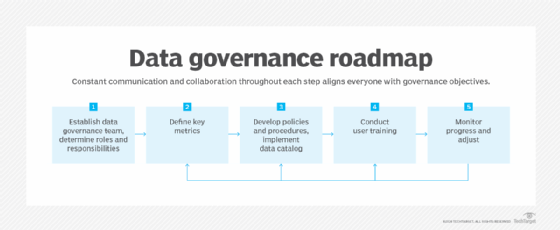Getty Images
Successful data operations follow a data governance roadmap
Implementing a data governance strategy requires a roadmap to keep everyone on track and overcome challenges. Follow eight key steps for best results.
Identifying data governance needs is only one part of a successful program. Organizations should use a data governance roadmap that details the necessary steps to implement and sustain a data governance framework.
A roadmap defines clear processes, roles and responsibilities to ensure that data governance initiatives align with organizational goals, and that they are executable. Best practices call for a data governance team to oversee the development and rollout of data governance policies.
A well-planned roadmap isn't immune to the challenges that many organizations encounter during implementation. Part of the planning should anticipate common problems and prepare responses, should they occur.
8 steps of a successful data governance roadmap
Data governance needs and goals can vary depending on the organization. Successful governance roadmaps follow eight general steps that each organization can tailor for its situation.
Establish a data governance team
The foundation of a successful data governance program is a dedicated team. It should include key stakeholders such as data stewards, data owners, IT professionals and legal advisors. The team is responsible for defining and enforcing data governance policies, ensuring compliance and addressing data-related issues.
Define key metrics to determine success
Identifying KPIs is crucial for measuring the success of data governance efforts. KPIs provide insights into the effectiveness of the data governance program and highlight areas for improvement. Common metrics include data quality scores, compliance rates, data usage and user satisfaction.
Develop governance policies and procedures
Comprehensive governance policies and procedures help maintain data integrity and security. Policies should cover data classification, data access, data usage and data protection. Establishing standardized procedures ensures consistency in data management practices across the organization.
Determine roles and responsibilities
Defining roles and responsibilities is critical for accountability and efficient data management. Specify who is responsible for data quality, security and compliance. Incorporate privacy and access controls for different user levels to ensure data is accessible only to authorized personnel, protecting sensitive information. Consider implementing a zero-trust security environment to maximize the protection of data.
Implement a data catalog or lineage tool
A data catalog or lineage tool manages and tracks data assets. The tool provides a centralized repository for metadata, making it easier to locate and understand data. It also helps trace data lineage, offering insights into the data's origin, transformation and usage, which is important for compliance and auditing purposes.
Provide training for employees and users
Continuous training and education are essential for the successful implementation of data governance. Employees at all levels should be aware of data governance policies, their roles in maintaining data quality and the importance of data security. Regular training sessions and workshops can help build a data-centric culture within the organization.
Monitor progress and adjust
Regularly monitor data governance activities to ensure the program stays on track and meets its objectives. Periodic audits, assessments and reviews help identify gaps and areas for improvement. Use the findings from evaluations to adjust policies, procedures and strategies. Data loss prevention tools can help determine any unauthorized use or attempted exfiltration of sensitive data.
Maintain constant communication
Effective communication is the backbone of a successful data governance program. Communicate regular updates on goals, progress, challenges and issues to all stakeholders. Communication fosters a collaborative environment and keeps everyone aligned with data governance objectives.

Challenges in data governance implementation
Building a successful data governance program is rarely straightforward. Organizations can encounter a variety of challenges during the implementation process.
Complexity of data governance programs
Data governance programs can be complex due to large data sets, diverse data sources and varying data management practices. The complexity can make it challenging to enforce standardized policies and procedures across the organization.
Poor communication
Leadership must effectively communicate the importance of data governance to employees and ensure everyone has a clear understanding of goals and responsibilities. The lack of collaboration between teams can hinder the progress of data governance initiatives. It commonly occurs when data governance is done as a one-time afterthought, as opposed to a core component built into a data governance lifecycle.
Wrong or vague goals and objectives
Setting vague or unrealistic goals can derail a data governance program. It is essential to establish clear, achievable objectives that align with the organization's overall strategy. Goals should be SMART: specific, measurable, attainable, relevant and time-bound. Goals that have a high-level vision of success, such as "our governance will be world-class," need observable, measurable metrics to track achievement.
Lack of training
Without proper training, employees might lack the necessary skills and knowledge to adhere to data governance policies. Continuous education and training programs ensure employees understand their roles, responsibilities and can effectively contribute to data governance efforts.
Lack of resources
Insufficient resources -- budget, personnel or technology -- can impede the success of a data governance program. Resource issues often stem from a lack of leadership support or investment at higher levels of management. Successful data governance depends on securing the necessary resources and gaining executive support. It can help to make data governance an objective within the larger context of the business or applications, as opposed to an independent goal that doesn't have a clear stakeholder.
Jerald Murphy is senior vice president of research and consulting with Nemertes Research. With more than three decades of technology experience, Murphy has worked on a range of technology topics, including neural networking research, integrated circuit design, computer programming and global data center design. He was also the CEO of a managed services company.









